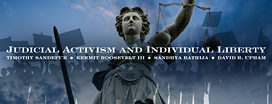Timothy Sandefur’s discussion of rational basis review raises at least two important questions. The first is whether there’s something inherently wrong with the test. Should rational basis review ever be used?
Rational basis review is certainly very deferential. If it’s a rule that, in practice, amounts to “uphold everything,” then I thinkit probably should not be used—it would be simpler just to say that the individual has no right, or no judicially enforceable one. It doesn’t amount to that, though, because as Sandefur notes there are somewhat unpredictable occasions on which it turns out to have teeth.
As to the precise features of the test, I agree that it’s strange for courts to hypothesize justifications for a law, and likewise for them to require challengers to disprove all possible justifications. But I wonder how often these things actually happen. (As Sandefur points out, it’s not really possible to disprove all possible justifications, since there’s an infinite range.) When I actually look at the cases Sandefur cites, I tend not to be as alarmed as he is. Take Hettinga as an example. The D.C. Circuit affirmed a 12(b)(6) dismissal not because the government “merely sa[id] the law was rational” but because it offered a specific rationale: Hettinga had been benefitting from a regulatory exemption that gave him a competitive advantage over rivals, and that exemption and consequent advantage were now interfering with the regulatory scheme. (Parenthetically, it’s unclear to me why protecting an individual’s relative liberty—the advantage he has by virtue of government regulation of competitors—is a libertarian position. Surely the better choice is to challenge the regulation of the competitors. And if market freedom for all is unattainable, why not a level playing field?) Hettinga’s pleadings, accepted as true, did not negate that justification, so there was no need to allow the introduction of evidence. At least, that’s what the court said.
In sum, rational basis review can be described in ways that make it seem absurd. I’m not so sure it really functions that way much in practice. But in any case, I’m not committed to the precise current formulation of rational basis review. I am, however, committed to the idea that there are proper occasions for deference. So now let’s turn to that.
Sandefur asks, why use rational basis review in some cases and not others? This is the key question, which I tried to address in my opening post. When should judicial review be deferential, and when should it be aggressive? I try to provide an account of (some of) the factors that go into this decision in The Myth of Judicial Activism. But rather than recapitulate that discussion, let me turn to footnote four of the Carolene Products decision, since it’s the topic of one of Sandefur’s replies here.
Footnote four, Sandefur argues, subdivides rights into enforceable and nonenforceable without constitutional instruction and picks out for special favor the rights that are seen as “instrumental to the idealized ‘democratic process.’” I don’t think so. I think that footnote four is actually a comprehensive theory of judicial review, albeit one that emerges from a particular historical context. So here is a short version of my account of it (longer version here):
The Carolene Products Court had come to see the Lochner-era jurisprudence as indefensible because it overrode legislative assessment of the public interest without any clear explanation as to why courts were better able to make the decision. Those cases looked retrospectively like courts just second-guessing policy choices, which they aren’t supposed to do. (Lochner notably disavows this power.) Footnote four attempts to answer the question of when aggressive judicial review is legitimate—when courts can strike down democratic enactments without being accused of simply substituting their own policy preferences.
Its answer, importantly, is not just something about the democratic process or non-economic rights. It has several elements. First, the footnote says, courts can enforce the text of the constitution. Enumerated rights, whether economic or not, whether contributing to the political process or not, can be enforced. That is why nude dancing and flag burning are aggressively protected—because they are considered to constitute speech protected by the First Amendment. The right to earn a living, on the other hand, is not in the Constitution, and property is protected only conditionally under the Due Process Clause. (Sandefur seems to believe that some enumerated economic rights are not being enforced, but I am less confident than he is in his reading of the text that purportedly confers those rights.) Second, even without textual warrant, courts can be aggressive in striking down laws that restrict the political process. This makes sense—the whole argument for deference to the legislature is that it represents the will of the people, but laws that restrict the political process subvert that justification. Third, the footnote identifies one situation in which the legislative assessment of the public interest is likely to be suspect: burdens fall on a politically weak group and benefits go to a stronger one. Here again, judicial second-guessing is appropriate without more explicit textual authorization.
That third part of the footnote, I think, was meant to be implemented in due process cases—maybe cases like Bruner—as a way of enforcing the public interest requirement that both Sandefur and I find in the due process clause. So when Sandefur argues for more meaningful judicial scrutiny of economic regulation in order to protect political outsiders, I am on board. (And I think he likewise should approve of footnote four.) But the flip side of this concern for politically weak minorities—the flip side of the argument that more aggressive judicial review is appropriate in such cases—is that less aggressive judicial review must be appropriate in other cases. That, perhaps, is where Sandefur and I part company, because I don’t think that the libertarian project is aimed merely at reducing regulation that burdens the politically weak.

